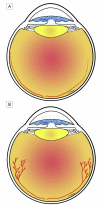Effects of oxygen on the development and severity of retinopathy of prematurity
- PMID: 23791404
- PMCID: PMC3740273
- DOI: 10.1016/j.jaapos.2012.12.155
Effects of oxygen on the development and severity of retinopathy of prematurity
Abstract
In 1942, when retinopathy of prematurity (ROP) first manifested as retrolental fibroplasia, the technology to monitor or regulate oxygen did not exist, and a fundus examination of preterm infants was not routinely performed. Supplemental, uncontrolled oxygen at birth has since been found to cause retrolental fibroplasia. At the same time, technological advances have made it possible to regulate oxygen and detect early forms of ROP. Nevertheless, despite our better understanding of ROP and ongoing investigations of supplemental therapeutic oxygen, including recent clinical trials (Surfactant, Positive Airway Pressure, Pulse Oximetry Randomized Trial [SUPPORT] and Benefits of Oxygen Saturation Targeting [BOOST]), the best oxygen profiles to reduce ROP risk while optimizing preterm infant health and development remain unknown. This article reviews major studies on oxygen use in preterm infants and the effects on the development of ROP.
Copyright © 2013 American Association for Pediatric Ophthalmology and Strabismus. Published by Mosby, Inc. All rights reserved.
Figures


Comment in
-
Effects of oxygen on the development and severity of retinopathy of prematurity.J AAPOS. 2013 Dec;17(6):650-2. doi: 10.1016/j.jaapos.2013.08.003. Epub 2013 Nov 5. J AAPOS. 2013. PMID: 24200805 No abstract available.
-
Reply: To PMID 23791404.J AAPOS. 2013 Dec;17(6):652. doi: 10.1016/j.jaapos.2013.10.001. Epub 2013 Nov 9. J AAPOS. 2013. PMID: 24215804 No abstract available.
Similar articles
-
Oxygen Saturation Targeting and Bronchopulmonary Dysplasia.Clin Perinatol. 2015 Dec;42(4):807-23. doi: 10.1016/j.clp.2015.08.008. Epub 2015 Sep 28. Clin Perinatol. 2015. PMID: 26593080 Review.
-
Evidence for oxygen use in preterm infants.Acta Paediatr. 2012 Apr;101(464):29-33. doi: 10.1111/j.1651-2227.2011.02548.x. Acta Paediatr. 2012. PMID: 22404889 Review.
-
[Incidence of retrolental fibroplasia in low birth weight infants receiving oxygen therapy].Orv Hetil. 1981 Aug 9;122(32):1943-6. Orv Hetil. 1981. PMID: 7029395 Hungarian. No abstract available.
-
Supplemental oxygen for the treatment of prethreshold retinopathy of prematurity.Cochrane Database Syst Rev. 2003;2003(2):CD003482. doi: 10.1002/14651858.CD003482. Cochrane Database Syst Rev. 2003. PMID: 12804470 Free PMC article. Review.
-
Oxygen targets for preterm infants.Neonatology. 2013;103(4):341-5. doi: 10.1159/000349936. Epub 2013 May 31. Neonatology. 2013. PMID: 23736013 Review.
Cited by
-
Mitochondrial control of hypoxia-induced pathological retinal angiogenesis.Angiogenesis. 2024 Nov;27(4):691-699. doi: 10.1007/s10456-024-09940-w. Epub 2024 Aug 3. Angiogenesis. 2024. PMID: 39096357 Free PMC article.
-
What is your optimal target of oxygen during general anesthesia in pediatric patients?Anesth Pain Med (Seoul). 2024 Oct;19(Suppl 1):S5-S11. doi: 10.17085/apm.23103. Epub 2023 Oct 30. Anesth Pain Med (Seoul). 2024. PMID: 39045749 Free PMC article.
-
Markers of Hypoxia and Metabolism Correlate With Cell Differentiation in Retina and Lens Development.Front Ophthalmol (Lausanne). 2022 Apr 22;2:867326. doi: 10.3389/fopht.2022.867326. eCollection 2022. Front Ophthalmol (Lausanne). 2022. PMID: 38983523 Free PMC article.
-
Potential therapeutic effects of baicalin and baicalein.Avicenna J Phytomed. 2024 Jan-Feb;14(1):23-49. doi: 10.22038/AJP.2023.22307. Avicenna J Phytomed. 2024. PMID: 38948180 Free PMC article. Review.
-
Evaluating the causes of retinopathy of prematurity relapse following intravitreal bevacizumab injection.BMC Ophthalmol. 2024 Jun 21;24(1):265. doi: 10.1186/s12886-024-03528-0. BMC Ophthalmol. 2024. PMID: 38907228 Free PMC article.
References
-
- Terry TL. Extreme prematurity and fibroblastic overgrowth of persistent vascular sheath behind each crystalline lens: (1) preliminary report. Am J Ophthalmol. 1942;25:203–4. - PubMed
-
- Finer N, Leone T. Oxygen saturation monitoring for the preterm infant: The evidence basis for current practice. Pediatr Res. 2009;65:375–80. - PubMed
-
- Saugstad OD, Speer CP, Halliday HL. Oxygen saturation in immature babies: Revisited with updated recommendations. Neonatology. 2011;100:217–18. - PubMed
-
- Oski FA. Clinical implications of the oxyhemoglobin dissociation curve in the neonatal period. Crit Care Med. 1979;7:412–18. - PubMed
Publication types
MeSH terms
Substances
Grants and funding
LinkOut - more resources
Full Text Sources
Other Literature Sources
Medical


